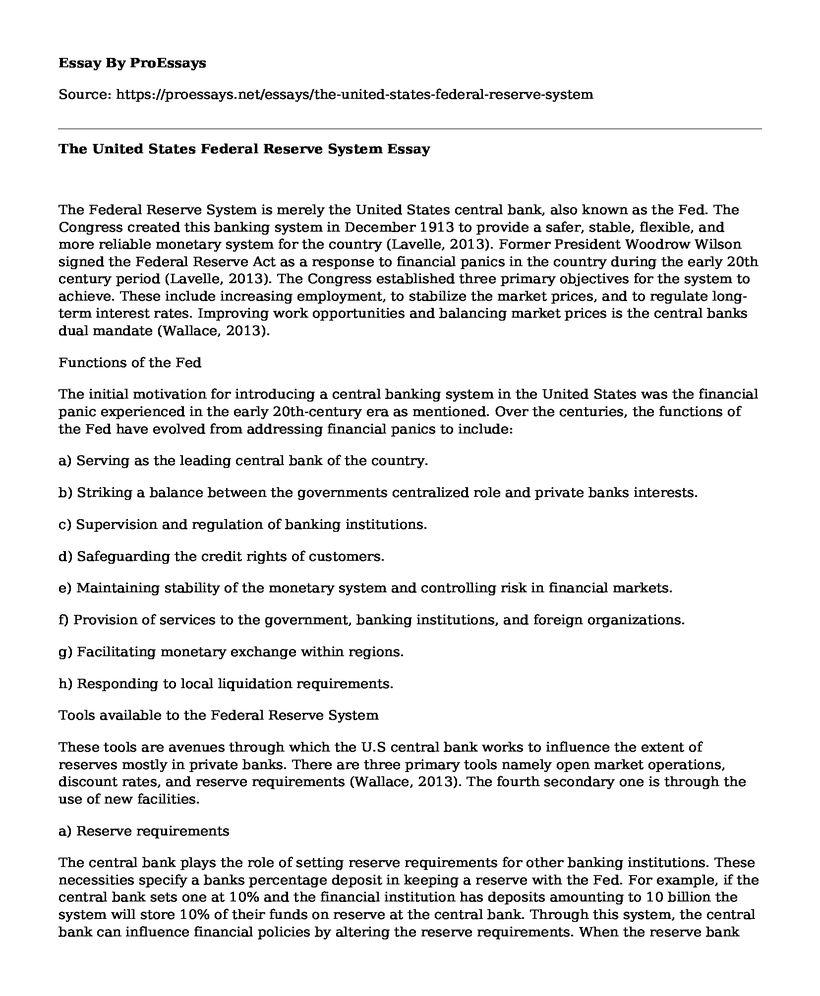The Federal Reserve System is merely the United States central bank, also known as the Fed. The Congress created this banking system in December 1913 to provide a safer, stable, flexible, and more reliable monetary system for the country (Lavelle, 2013). Former President Woodrow Wilson signed the Federal Reserve Act as a response to financial panics in the country during the early 20th century period (Lavelle, 2013). The Congress established three primary objectives for the system to achieve. These include increasing employment, to stabilize the market prices, and to regulate long-term interest rates. Improving work opportunities and balancing market prices is the central banks dual mandate (Wallace, 2013).
Functions of the Fed
The initial motivation for introducing a central banking system in the United States was the financial panic experienced in the early 20th-century era as mentioned. Over the centuries, the functions of the Fed have evolved from addressing financial panics to include:
a) Serving as the leading central bank of the country.
b) Striking a balance between the governments centralized role and private banks interests.
c) Supervision and regulation of banking institutions.
d) Safeguarding the credit rights of customers.
e) Maintaining stability of the monetary system and controlling risk in financial markets.
f) Provision of services to the government, banking institutions, and foreign organizations.
g) Facilitating monetary exchange within regions.
h) Responding to local liquidation requirements.
Tools available to the Federal Reserve System
These tools are avenues through which the U.S central bank works to influence the extent of reserves mostly in private banks. There are three primary tools namely open market operations, discount rates, and reserve requirements (Wallace, 2013). The fourth secondary one is through the use of new facilities.
a) Reserve requirements
The central bank plays the role of setting reserve requirements for other banking institutions. These necessities specify a banks percentage deposit in keeping a reserve with the Fed. For example, if the central bank sets one at 10% and the financial institution has deposits amounting to 10 billion the system will store 10% of their funds on reserve at the central bank. Through this system, the central bank can influence financial policies by altering the reserve requirements. When the reserve bank also wants to lower the amount of finances in the system, it increases the reserve limit for banks forcing them to draw money out of circulation and place it on reserve and vice versa.
b) Discount rate
The central bank plays the role of setting interest rates charged by banks to borrow money at facilities for getting money from the Fed known as Discount Windows. The reserve system has the power to affect financial policies by altering the discount rates. Raising the rate decreases the amount in the system thus discouraging banks from borrowing, whereas reducing these rates provides an excellent lending opportunity for financial institutions.
c) Federal funds rate
The federal rate is the interest percentage financial institutions charge each other in the borrowing and lending process from the Fed. These institutions have the power to borrow from each other to create a balance between those that have a lot of money on reserve and those that dont. Therefore, the federal funds rate is the percentage which the central bank applies to other banks in exchanging federal funds.
d) New facilities
A new temporary tool was created to address issues concerning the mortgage and housing crisis in the country (Wallace, 2013). They introduced three tools namely the Term Auction Facility, the Term Securities Lending Facility, and the Primary Dealer Credit Facility. They are primarily used to inject cash and treasuries securities into the finance system, and also enable the Fed to lend money to primary dealers directly.
References
Lavelle, K. C. (2013). Money and banks in the American political system. Cambridge:
Cambridge University Press.
Wallace, W. H. (2013). The American monetary system: An insider's view of financial
institutions, markets, and monetary policy. Cham: Springer Press.
Cite this page
The United States Federal Reserve System. (2021, May 14). Retrieved from https://proessays.net/essays/the-united-states-federal-reserve-system
If you are the original author of this essay and no longer wish to have it published on the ProEssays website, please click below to request its removal:
- Healthcare Services and Resources to Native Americans
- How to Commit Fraud? - Essay Sample
- Real Estate Investment Paper Example
- Wage Discrimination and the Residual Approach Paper Example
- Paper Example on Country Analysis: China
- The Big Short: Examining the Causes of the 2007-2008 Financial Crisis - Essay Sample
- Essay Example on China's Pollution Menace: PM2.5, Motor Vehicles,Industry, Fossil Fuels







